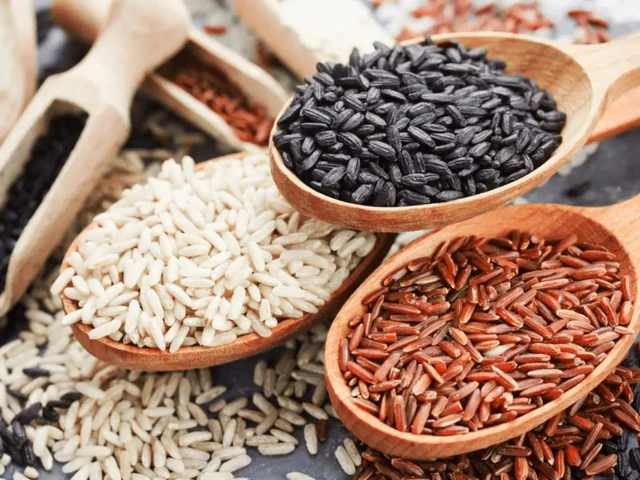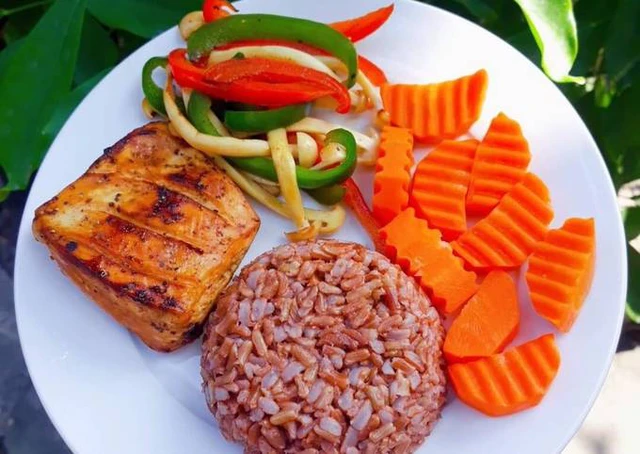Brown rice is a great way to upgrade your diet and improve your overall health. By soaking it thoroughly before cooking, combining it with other foods, chewing it thoroughly, and listening to your body, you will fully enjoy the benefits that this "brown pearl" brings.
1. Why is brown rice so favored?
 |
| Brown rice has many varieties. |
Unlike white rice, which has had its nutritious bran and germ removed, brown rice retains all three components: bran, endosperm, and germ. Thanks to this bran and germ, brown rice is nutritionally superior to white rice:
Rich in fiber: 2-3 times more than white rice, helps you feel full longer, aids digestion, prevents constipation and stabilizes blood sugar.
Contains many vitamins and minerals: Especially B vitamins (B1, B3, B6), magnesium, manganese, selenium, phosphorus, iron... necessary for metabolism and body functions.
Antioxidants: Brown rice bran contains many powerful antioxidants such as flavonoids and phenolic acids, which help fight free radicals and protect cells.
Low sugar, low glycemic index: Helps control blood sugar better, very beneficial for people with diabetes or those who want to prevent diabetes.
2. How to eat brown rice properly to benefit your health?
To maximize the benefits of brown rice and make it suitable for each person's body, you need to pay attention to the following points:
Choose the right type of brown rice
There are many different types of brown rice on the market, such as brown rice, red rice, and black rice. Each type has a slightly different flavor and nutritional content.
Brown rice: Easy to eat and most popular.
Red rice, black rice: Richer in antioxidants, often has a more aromatic flavor and chewy texture. Experiment to find the type that suits your taste.
Prepare carefully before cooking
Rinsing rice: Before cooking, rinse brown rice under cold running water to remove any dust or excess starch. This will help prevent a tough texture. Rinsing can also help remove about 10% of the arsenic in rice.
Soaking brown rice: This is an extremely important step but is often overlooked. Brown rice has a hard shell, so it needs to be soaked to soften it, making it more sticky and easier to digest. The ideal soaking time is 2-8 hours, or even overnight. Soaking also helps reduce phytic acid - a substance that can interfere with mineral absorption.
A little apple cider vinegar or lemon juice can be added to the soaking water to help neutralize phytic acid, which can inhibit nutrient absorption.
Standard water ratio: Depending on the type of brown rice (brown rice, glutinous brown rice, red brown rice, black brown rice), the water ratio will be different. Normally, brown rice needs more water than white rice, about 1 rice: 2 - 2.5 water. You can adjust to find the ratio that suits your preference for stickiness.
Cooking method
Bring water to a boil in a pot, add the rice and simmer until tender (about 30-40 minutes). For a fluffier texture, cover the pot and let it sit for 5-10 minutes after turning off the heat. If you are using an electric rice cooker, follow the instructions provided by the manufacturer of your rice cooker. Many rice cookers have a specific setting for brown rice.
Cooked brown rice can be stored in an airtight container in the refrigerator for 2 - 3 days. When reheating, add a small amount of water or broth to prevent drying out.
Chew thoroughly when eating
Brown rice has a tougher and harder texture than white rice. Chewing thoroughly not only helps to crush food, reducing the burden on the stomach, but also helps the body absorb nutrients better.
Chewing thoroughly also helps you feel full faster and eat less, which is beneficial for weight control.
Eat in moderation and in varied combinations.
 |
| You should combine brown rice with protein and green vegetables to balance nutrition. |
Don't replace white rice with brown rice all at once: If you're just starting out, start slowly. For example, eat 1-2 meals of brown rice per week, then gradually increase. Sudden changes can cause your body to not have time to adapt to the increased amount of fiber, causing bloating or indigestion.
Combine with protein and green vegetables: Brown rice is a good source of carbs but needs to be combined with adequate protein (lean meat, fish, eggs, beans, nuts) and a variety of green vegetables in each meal. This helps balance nutrition, keeps you full longer and provides adequate vitamins and minerals.
Listen to your body: Everyone is different. If you experience persistent indigestion or bloating, reconsider the amount of brown rice you eat or how it is prepared and consult a nutritionist.
3. Who needs to be careful when eating brown rice?
Although brown rice is very good, some people should consult a doctor or nutritionist before changing their diet:
People with acute digestive problems: Gastric ulcers, irritable bowel syndrome in severe stages.
People who are underweight or severely malnourished: High fiber intake can cause rapid fullness, reducing energy absorption.
Children and the elderly have weak digestive systems: Should be fed in small amounts and increased gradually.
According to suckhoedoisong.vn
Source: https://baokhanhhoa.vn/doi-song/am-thuc/202506/an-gao-lut-dung-cach-de-toi-uu-hoa-loi-ich-suc-khoe-2d33d42/


![[Photo] President Luong Cuong talks on the phone with South Korean President Lee Jae Myung](https://vphoto.vietnam.vn/thumb/1200x675/vietnam/resource/IMAGE/2025/6/13/eee54a4c903f49bda277272b1dda68e8)


























































































Comment (0)